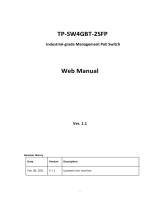
Table of content
1. Log into the Switch Web Interface .................................................................................................. 3
2. Switch Information ........................................................................................................................ 4
2.1 Global Information ............................................................................................................................ 4
2.2 Statistical Information ....................................................................................................................... 5
2.3 Log Information ................................................................................................................................. 6
2.4 Alarm List ........................................................................................................................................... 6
3. Port Management ......................................................................................................................... 7
3.1 Port Configuration ............................................................................................................................. 7
3.2 Port Isolation ..................................................................................................................................... 7
3.3 Mirroring Port ................................................................................................................................... 8
3.4 Rate Limited ...................................................................................................................................... 8
3.5 Storm Control .................................................................................................................................... 9
3.6 Port Energy Saving ............................................................................................................................. 9
4. PoE ............................................................................................................................................. 10
4.1 PoE Port Configuration .................................................................................................................... 10
4.2 Devices Power Supply ..................................................................................................................... 10
4.3 Timing Power Supply Configuration ................................................................................................ 11
4.4 Intelligent Power Supply Configuration .......................................................................................... 12
5. L2 Management .......................................................................................................................... 13
5.1 MAC address table .......................................................................................................................... 13
5.2 VLAN Configuration ......................................................................................................................... 13
5.3 GVRP ................................................................................................................................................ 16
5.4 Link Aggregation .............................................................................................................................. 16
5.5 MSTP Configuration ........................................................................................................................ 19
5.6 Loop Protection ............................................................................................................................... 20
5.7 DHCP-snooping ............................................................................................................................... 22
5.8 IGMP Snooping ................................................................................................................................ 23
5.8 802.1x authentication ..................................................................................................................... 24
6. Senior Management .................................................................................................................... 26
6.1 QOS Configuration........................................................................................................................... 26
6.2 ACL Configuration ............................................................................................................................ 27
6.3 SNMP Configuration ........................................................................................................................ 29
6.4 RMON .............................................................................................................................................. 30
6.5 LLDP Configuration .......................................................................................................................... 32
6.6 NTP Configuration ........................................................................................................................... 33
6.7 Anti Attack ....................................................................................................................................... 33
7. System Management ................................................................................................................... 34
7.1 User Settings ................................................................................................................................... 34
7.2 Network Settings ............................................................................................................................. 34
7.3 Alarm Configuration ........................................................................................................................ 35
7.4 Service Configuration ...................................................................................................................... 35
7.5 Configuration Management ............................................................................................................ 35
7.6 Firmware Update ............................................................................................................................ 36
7.8 Diagnostic Testing ............................................................................................................................ 36
7.9 Reboot Device ................................................................................................................................. 37






















